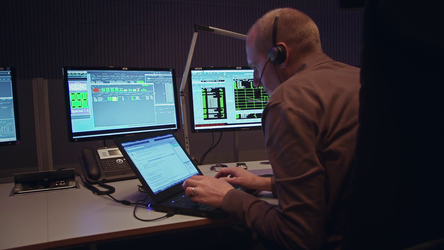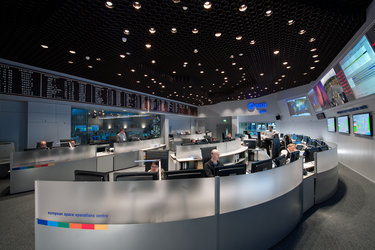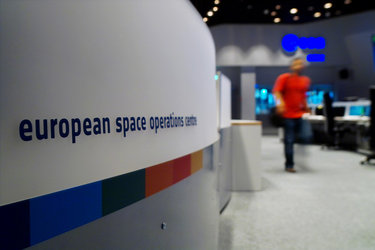Accept all cookies Accept only essential cookies See our Cookie Notice

About ESA
The European Space Agency (ESA) is Europe’s gateway to space. Its mission is to shape the development of Europe’s space capability and ensure that investment in space continues to deliver benefits to the citizens of Europe and the world.
Highlights
ESA - United space in Europe
This is ESA ESA facts Member States & Cooperating States Funding Director General Top management For Member State Delegations European vision European Space Policy ESA & EU Space Councils Responsibility & Sustainability Annual Report Calendar of meetings Corporate newsEstablishments & sites
ESA Headquarters ESA ESTEC ESA ESOC ESA ESRIN ESA EAC ESA ESAC Europe's Spaceport ESA ESEC ESA ECSAT Brussels Office Washington OfficeWorking with ESA
Business with ESA ESA Commercialisation Gateway Law at ESA Careers Cyber resilience at ESA IT at ESA Newsroom Partnerships Merchandising Licence Education Open Space Innovation Platform Integrity and Reporting Administrative Tribunal Health and SafetyMore about ESA
History ESA Historical Archives Exhibitions Publications Art & Culture ESA Merchandise Kids Diversity ESA Brand CentreLatest
Space in Member States
Find out more about space activities in our 23 Member States, and understand how ESA works together with their national agencies, institutions and organisations.
Science & Exploration
Exploring our Solar System and unlocking the secrets of the Universe
Go to topicAstronauts
Missions
Juice Euclid Webb Solar Orbiter BepiColombo Gaia ExoMars Cheops Exoplanet missions More missionsActivities
International Space Station Orion service module Gateway Concordia Caves & Pangaea BenefitsLatest
Space Safety
Protecting life and infrastructure on Earth and in orbit
Go to topicAsteroids
Asteroids and Planetary Defence Asteroid danger explained Flyeye telescope: asteroid detection Hera mission: asteroid deflection Near-Earth Object Coordination CentreSpace junk
About space debris Space debris by the numbers Space Environment Report In space refuelling, refurbishing and removingSafety from space
Clean Space ecodesign Zero Debris Technologies Space for Earth Supporting Sustainable DevelopmentLatest
Applications
Using space to benefit citizens and meet future challenges on Earth
Go to topicObserving the Earth
Observing the Earth Future EO Copernicus Meteorology Space for our climate Satellite missionsCommercialisation
ESA Commercialisation Gateway Open Space Innovation Platform Business Incubation ESA Space SolutionsLatest
Enabling & Support
Making space accessible and developing the technologies for the future
Go to topicBuilding missions
Space Engineering and Technology Test centre Laboratories Concurrent Design Facility Preparing for the future Shaping the Future Discovery and Preparation Advanced Concepts TeamSpace transportation
Space Transportation Ariane Vega Space Rider Future space transportation Boost! Europe's Spaceport Launches from Europe's Spaceport from 2012Latest

ESOC Main Control Room
Thank you for liking
You have already liked this page, you can only like it once!
In September 1967, the European Space Operations Centre (ESOC) was formally inaugurated in Darmstadt, Germany, to provide satellite control for the European Space Research Organisation, today known as ESA. ESOC began just a decade after the 1957 start of the space age, when the Soviet Union launched Sputnik 1, the first artificial satellite.
The facility later known as ESOC had been established in the fall of 1963 as ESDAC, the European Space Data Centre; with the renaming and re-purposing for spacecraft operations, the centre and its 90 staff moved to a new facility located on the west side of Darmstadt. ESOC was opened on 8 September 1967 by then-Minister of Research of the Federal Republic of Germany, Gerhard Stoltenberg.
By May 1968, ESOC, as part of ESRO, was already conducting its first operations, controlling ESRO-2B, a scientific research satellite and the first in a long series of successful missions operated from ESOC for ESRO, and later ESA.
The establishment of ESOC and the subsequent evolution of ESRO and ELDO into ESA with the Ariane launcher programme proved that Europeans working together could not only build satellites and boosters, but could also operate sophisticated missions as well. In the decades since then, robotic satellites controlled from ESOC have voyaged deep into our Solar System, exploring not only our home planet, but also the Moon, the Sun, Venus, Mars and Titan - a moon of Saturn and the most remote place ever reached by a man-made object. In 2014, Rosetta reached comet 67P/Cheryumoc-Gerasimenko, dispatching a lander to the surface.
Closer to home, Earth missions flown from ESOC have contributed to understanding our planet's atmosphere, oceans, land, ice, weather, climate and changing environment.
-
CREDIT
ESA -
LICENCE
CC BY-SA 3.0 IGO or ESA Standard Licence
(content can be used under either licence)

ESOC MCR 1960s

ESOC control room

Mission control system

ESOC Main Control Room















 Germany
Germany
 Austria
Austria
 Belgium
Belgium
 Denmark
Denmark
 Spain
Spain
 Estonia
Estonia
 Finland
Finland
 France
France
 Greece
Greece
 Hungary
Hungary
 Ireland
Ireland
 Italy
Italy
 Luxembourg
Luxembourg
 Norway
Norway
 The Netherlands
The Netherlands
 Poland
Poland
 Portugal
Portugal
 Czechia
Czechia
 Romania
Romania
 United Kingdom
United Kingdom
 Slovenia
Slovenia
 Sweden
Sweden
 Switzerland
Switzerland
























